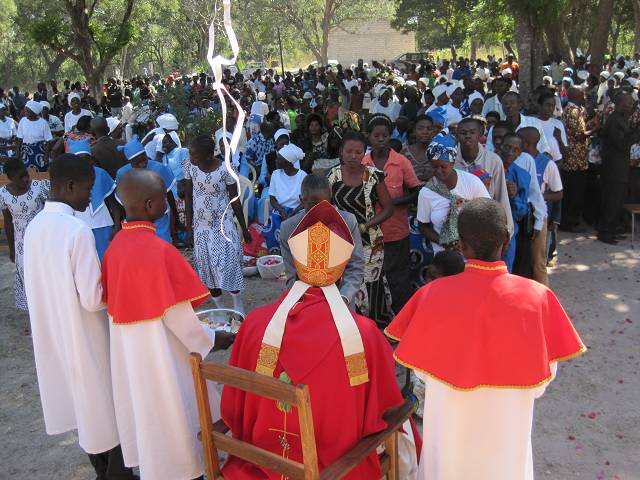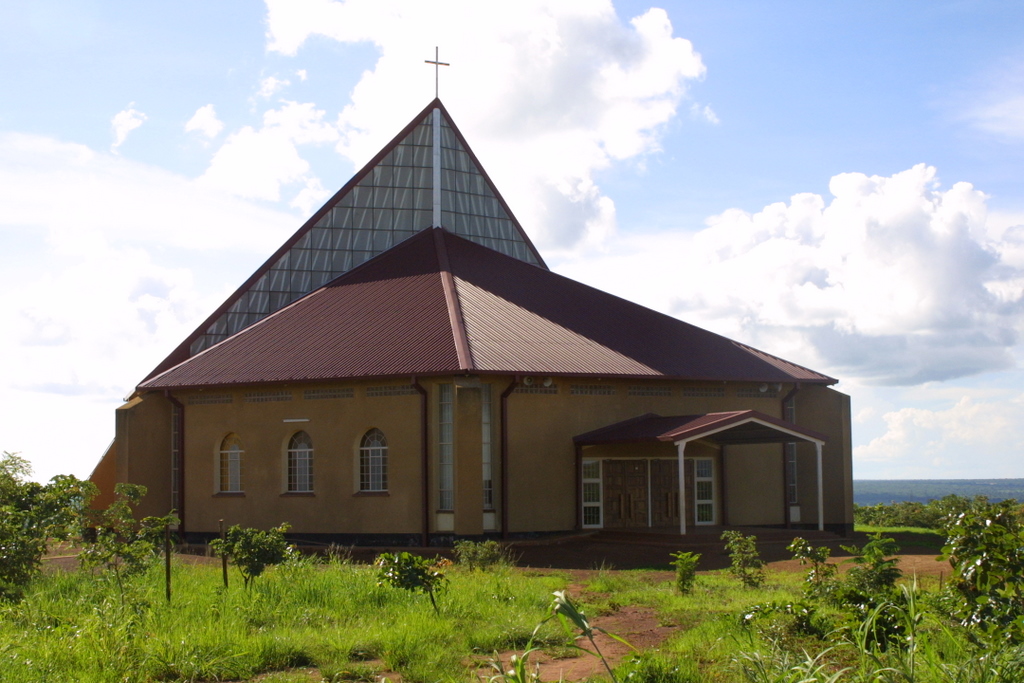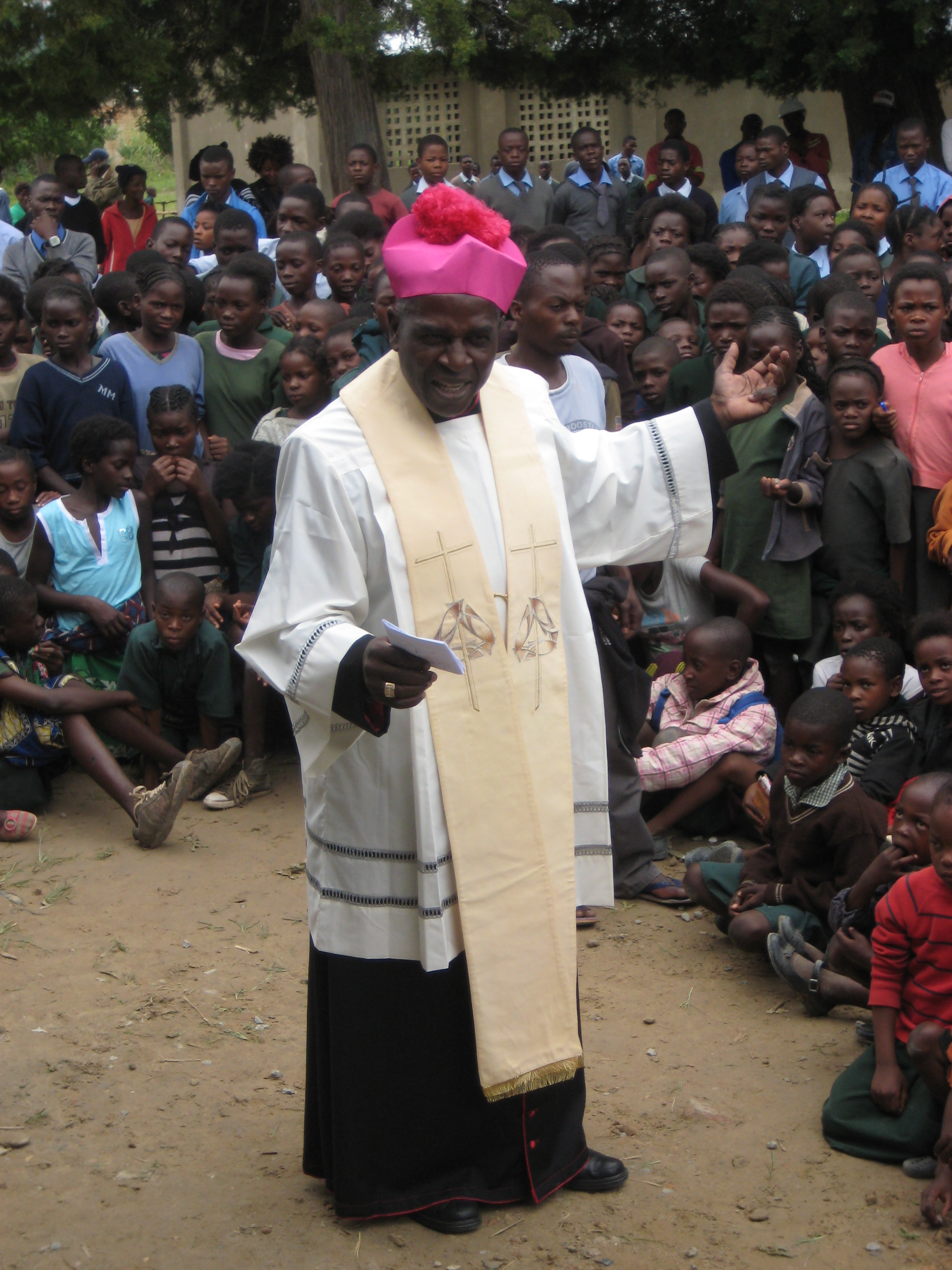History of the Diocese of Mpika
The history of the Diocese of Mpika is very closely linked to the arrival of the first catholic missionaries, the White Fathers (officially called: Missionaries of Africa) in the North of Zambia.

On 5 May 1891, missionaries who had tried to settle in the area of Chief Mponda, to the South of Lake Nyassa, were asked by their superiors to move to Karema on Lake Tanganyika. They traveled the length of lake Nyassa, disembarked at Karonga and took the “Stevenson Road” which follows the ridge forming the present Zambia-Tanzania border. After a good month of walking they reached Mwene Mambwe, the home of the Paramount Chief of the Mambwe people, some 40 km South of Lake Tanganyika. There they stopped for a rest, then decided to settle down.
They remained at Old Mambwe for four years before moving into Bemba country. Father Van Oost made the first contact with Chief Makasa. On 31 May 1895, Father Joseph Dupont appeared on the scene. He became the founder of Kayambi Mission and later in 1897 was appointed Bishop of the new Vicariate of Nyassa. Very soon Bishop Dupont became known as “Moto-Moto”, the fiery one.
In 1913 the Pro-Vicariate of Nyaasa was divided in two: The southern part became the Vicariate of Nyassa and the northern sector the Vicariate of Bangweulu. Bishop Dupont was later succeeded by Bishop Etienne Larue. In 1933 a new diocese was created as a “missio sui juris”. It comprised most of the four districts (Mpika, Chinsali, Isoka and Lundazi) in Northern Rhodesia (Zambia) as well as four districts in Nyassaland (Malawi).
From July 1937 to May 1938 more changes took place: The Lwangwa valley became the south-eastern boundary of the Vicariate, Lundazi district was handed over to the Prefecture of Fort Jameson (Chipata), the four districts of Nyassa were added to the Vicariate of Nyassa, Kayambi and the district of Abercorn (Mbala) with the exception of Rosa Mission were added to the Vicariate of Lwangwa and so was Serenje District. Bishop Horst was its first Apostolic Vicar. He established his headquarters at Ilondola in Chinsali District.
In mid-1950 Bishop Joseph van den Biesen moved the vicariate’s administration to Abercorn (Mbala).
In 1958, with the establishment of the Hierarchy of Northern Rhodesia and Nyassaland, the vicariate became a diocese under the Apostolic Administrator, Fr. Adolf Fürstenberg who had been appointed after the resignation of Bishop van den Biesen.
Bishop Fürstenberg was ordained bishop on June 29, 1959 and headed the Diocese until his retirement on June 21, 1987 when he was succeeded by Bishop Telesphore-George Mpundu, the first Zambian Bishop of Mbala. The diocese had changed its name when in November 1967 the township of Abercorn reverted to its old name Mbala.
In 1989 the Diocese had 17 parishes: Kayambi (1895), Chilonga (1899), Ilondola and Chalabesa (1934), Katibunga and Mulilansolo (1936), Mambwe (1938), Mulanga (1939), St. Paul’s – Mbala (1948), Serenje (1953), Kopa (1961), Lwitikila (1962), Isoka (1963) Chinsali and St. Francis – Mbala (1966), Mpika (1970) and Mpulungu (1973).
From the very beginning, the opening of catholic schools was one of the primary concerns at every mission foundation. This was not only to dispense education but also to recruit catechumen, catechists and lay-leaders and to prepare the way for the formation of local clergy. The first Zambian priest of the diocese, Father Pascal Kakokota, was ordained in the pro-cathedral of Ilondola in 1949.
The education of girls was another priority in the early days. Already in 1937, the White Sisters opened the first school for girls in Kayambi. This concern culminated in the opening of the Lwitikila Secondary School for Girls in August 1961.
A third area of concern for the diocese was the health of the people. Bishop Moto-Moto (Dupont) himself was acclaimed as the great healer of the sick, a reputation which gained him admission to the court of the powerful chief Mwamba. Right from the beginning patients were attracted to the rather primitive dispensary of Kayambi which was taken over by the White Sisters in 1905. Over the years dispensaries – now known as Rural Health Centres – increased in size and numbers: Chilonga hospital with its 220 bed capacity and large out-patients facility is well known. In addition there are six 30-bed (or more) Rural Health Centers in Kayambi, Mulanga, Mulilansolo, Ilondola, Chalabesa and Mambwe.
Major pastoral problems are related to the shortage of priests who can no longer adequately visit their people in the more than 450 centres. The very low living standard of the majority of the people in the rural areas is another problem. In times of economic recessions, adequate educational and medical facilities become increasingly difficult to provide. In their misfortune the people turn frequently to traditional diviners and witch doctors to seek answers and protection.
The Diocese counts about 120,000 baptized catholics, 22% of the population scattered over 107,663 square kilometers in more than 3,000 villages and 7 townships.
Relations and cooperation with the main-stream Christian “churches” such as the United Church of Zambia, the Methodist Church, the Anglican Church and the Seventh Day Adventists are excellent.
In June 1991, in order to move the HQ of the diocese to a more central place than Mbala, the diocese was renamed Mbala-Mpika. Subsequently, after due preparations the HQ of the diocese moved to Mpika in March 1995. The building of the new HQ along Kasama Road began the same year. In 1998 the new buildings were finalized. The HQ has an office block with the Bishop’s quarters, a convent for religious sisters, a presbytery, workshops and staff houses as well as the new St. Joseph’s Cathedral. In 1999 the diocese changed its name to: The Diocese of Mpika. In November of the same year the northern part of the diocese with the parishes Kayambi, Mambwe, Mpulungu and Mbala were handed over to the Archdiocese of Kasama, as previously planned.
The Diocese of Mpika has currently 16 Parishes: Chilonga (1899), Ilondola and Chalabesa (1934), Katibunga and Mulilansolo (1936), Mulanga (1938), Serenje (1953), Kopa (1961), Isoka (1963), Chinsali (1966), Mpika-St.Andrew’s. (1970), St. Monica (Ichengelo), in TAZARA (1990), Mpika-St. Joseph’s (2002), St. Mary’s Nakonde (2008), Nabwalya (2012) and Mpepo (2018).
On 1 May 2004, the new Cathedral of St. Joseph’s near Chitulika Township was blessed.

On 1 October 2004, Bishop Telesphore-George Mpundu was appointed Archbishop Coadjutor of Lusaka Archdiocese. At the same time he was made Apostolic Administrator of Mpika Diocese. On 21 November 2006 he took canonical possession of the Archdiocese of Lusaka. On 17 September 2007, Fr. Robert Lavertu M.Afr. was appointed Apostolic Administrator of the Diocese. On 17 July 2008, Fr. Ignatius Chama was appointed Bishop of Mpika. He served as Bishop of Mpika until 12 January 2012. That same day he was appointed Archbishop of Kasama and appointed Apostolic Administrator of Mpika Diocese. He remained diocesan administrator until 12 March 2016. Bishop Justin Mulenga was appointed Bishop of Mpika on 23 December 2015. He was consecrated Bishop of Mpika on 12 March 2016 by his predecessor Archbishop I. Chama. He took possession of the Diocese the very same day and is our Bishop since then.

